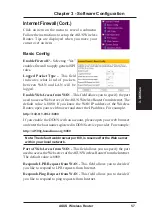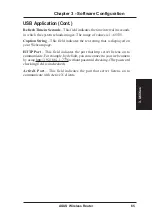
3. Utilities
ASUS Wireless Router
59
Chapter 3 - Software Configuration
USB Application
Click an item on the menu to reveal a submenu.
Follow the instructions to set up the ASUS Wireless
Router. Tips are displayed when you move your
cursor over an item.
FTP Server
FTP Server Mode – The ASUS
Wireless Router features an
embedded FTP server for USB
storage. Before using the FTP server,
ensure that your USB device fulfils
the following requirements.
•
The FTP server only works with supported USB devices. Supported devices
are listed on the ASUSTeK Web site at http://www.asus.com.
•
The ASUS router supports read/write functions for FAT or FAT32 file
systems and read-only functions for NTFS (NT file system) with compressed
or uncompressed files. Encrypted files are not supported. If your USB
storage device is formatted as a FAT or FAT32 file system, configure the
FTP server to work from the first partition (partition 0).
•
Devices with multi-partitions will be detected; however, only super users
and anonymous users can access devices configured with multi-partitions.
Other users can only access the directory /ftp_pub or /ftp_pvt/username/ in
partition 0.
Note: WL500g/b only supports USB Storage recognized as a “Mass
Storage Device”. It does not support other types of USB to IDE de-
vices. Most compatible USB storage devices are plug and play; you
do not have to power off the router when connecting these devices.
However, USB external storage cases for IDE devices require you
to restart the router after you connect them.
The following describes the available fields in the FTP Server screen.
Force to Eject USB Disk – When this item is enabled, pressing the “Eject”
button will allow the router to write the cached data back to the USB disk
before you remove the USB disk. Remove the USB Disk only after you
press the button and get the refreshed Web page. Otherwise, you will lose
the cached data.
Summary of Contents for WL-500b
Page 107: ...Appendix ASUS Wireless Router 107 ...
















































